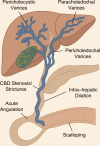Portal cavernoma cholangiopathy: A systematic review of current understanding, clinical significance, and management
- PMID: 41085547
- PMCID: PMC12520217
- DOI: 10.1097/HC9.0000000000000833
Portal cavernoma cholangiopathy: A systematic review of current understanding, clinical significance, and management
Abstract
Portal cavernoma cholangiopathy (PCC) is a rare condition characterized by abnormalities of the intrahepatic and extrahepatic bile ducts and the gallbladder, resulting from long-standing chronic portal vein thrombosis (cPVT). These vascular changes often occur in the setting of non-cirrhotic, non-neoplastic portal hypertension. Its prevalence among cPVT patients ranges from 4% to 92%, with an unweighted average of 45.2%, increasing to 67.0% in studies using magnetic resonance cholangiopancreatography (MRCP) or endoscopic retrograde cholangiopancreatography (ERCP). Although most patients remain asymptomatic, about 25% develop symptoms. Diagnosis mainly depends on imaging, with MRCP being the most accurate choice. The classification proposed by Llop and colleagues provides a useful framework by integrating anatomical involvement with the severity of biliary disease. However, combining this classification with the pathophysiological one could support a more personalized treatment approach. Management depends on symptom presentation. Asymptomatic patients are managed conservatively. Symptomatic cases may require endoscopic interventions; plastic stents are most commonly used, although they have around a 30% risk of hemobilia and a high re-intervention rate of ~50%. Interventional radiology techniques, particularly portal vein recanalization with transjugular intrahepatic portosystemic shunt (TIPS), exhibit high technical success rates (median 91%) and patency rates (median 81.8%). Surgical portosystemic shunts remain a key option for a subgroup of patients, with about 65% achieving symptom resolution after decompression alone, whereas liver transplantation is rarely indicated. Given the rarity of this condition and the limited quality of existing studies, we conducted this systematic review to provide a comprehensive overview of the current literature and to promote a more standardized approach to managing PCC. This review aims to fill knowledge gaps and enhance consistency in treatment strategies for this complex condition.
Keywords: TIPS; portal biliopathy; portal hypertension; portal vein thrombosis; shunt.
Copyright © 2025 The Author(s). Published by Wolters Kluwer Health, Inc. on behalf of the American Association for the Study of Liver Diseases.
Conflict of interest statement
Marco Senzolo is on the speaker’s bureau for Gore SRL. The remaining authors have no conflicts to report.
Figures







References
-
- Shin SM, Kim S, Lee JW, Kim CW, Lee TH, Lee SH, et al. Biliary abnormalities associated with portal biliopathy: Evaluation on MR cholangiography. AJR Am J Roentgenol. 2007;188:W341–W347. - PubMed
-
- Walser EM, Runyan BR, Heckman MG, Bridges MD, Willingham DL, Paz-Fumagalli R, et al. Extrahepatic portal biliopathy: Proposed etiology on the basis of anatomic and clinical features. Radiology. 2011;258:146–153. - PubMed
-
- Khuroo MS, Yattoo GN, Zargar SA, Javid G, Dar MY, Khan BA, et al. Biliary abnormalities associated with extrahepatic portal venous obstruction. Hepatology. 1993;17:807–813. - PubMed
Publication types
MeSH terms
LinkOut - more resources
Full Text Sources
Medical

